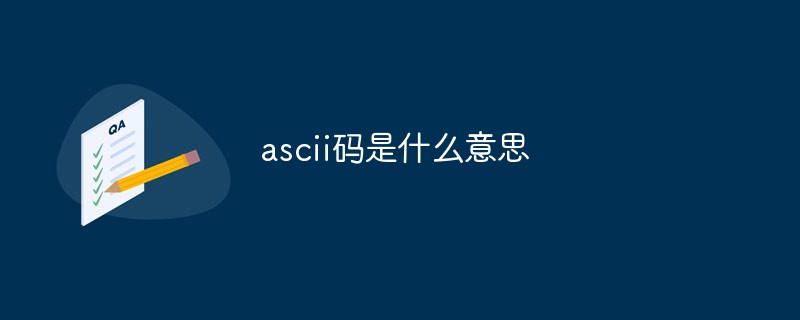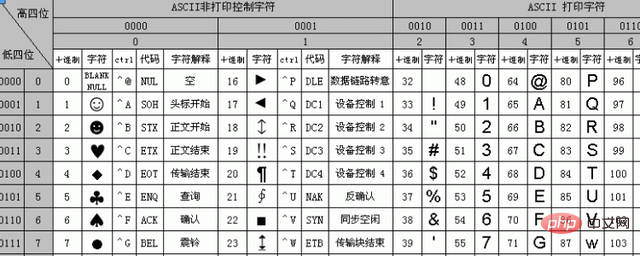what does ascii code mean
The ascii code is a computer coding system based on the Latin alphabet; the ascii code is the abbreviation of "American Standard Code for Information Interchange". It is mainly used to display modern English and other Western European languages. It is the most common information exchange Standard, using specified combinations of 7- or 8-bit binary numbers to represent 128 or 256 possible characters.

The operating environment of this tutorial: Windows 10 system, DELL G3 computer.
What does ascii code mean
ASCII (American Standard Code for Information Interchange): The American Standard Code for Information Interchange is a computer coding system based on the Latin alphabet, mainly Used to display modern English and other Western European languages. It is the most common standard for information exchange and is equivalent to the international standard ISO/IEC 646. ASCII was first published as a standardized type in 1967, and the last update was in 1986. So far, a total of 128 characters have been defined
Expression method
ASCII code uses a specified 7-bit or 8-bit binary number combination to represent 128 or 256 possible characters. Standard ASCII code, also called basic ASCII code, uses 7 binary digits (the remaining 1 binary digit is 0) to represent all uppercase and lowercase letters, numbers 0 to 9, punctuation marks, and special controls used in American English. character . Among them:
0~31 and 127 (33 in total) are control characters or special communication characters (the rest are displayable characters)
For example, control characters: LF (line feed), CR (return) Car), FF (page feed), DEL (delete), BS (backspace), BEL (ring), etc.;
Special characters for communication: SOH (head of text), EOT (end of text), ACK (Confirm), etc.;
ASCII values 8, 9, 10 and 13 are converted into backspace, tab, line feed and carriage return characters respectively. They do not have a specific graphic display, but will have different effects on text display depending on the application.
32~126 (95 in total) are characters (32 is a space), of which 48~57 are ten Arabic numerals from 0 to 9.
65~90 are 26 uppercase English letters, 97~122 are 26 lowercase English letters, and the rest are some punctuation marks, arithmetic symbols, etc.
Also note that in standard ASCII, its highest bit (b7) is used as a parity bit. The so-called parity check refers to a method used to check whether errors occur during code transmission. It is generally divided into two types: odd check and even check. Odd parity rules: the number of 1's in a byte of the correct code must be an odd number. If it is not an odd number, add 1 to the highest bit b7; even parity rules: the number of 1's in a byte of the correct code must be an even number. , if it is not an even number, add 1 to the highest bit b7.
The last 128 are called extended ASCII codes. Many x86-based systems support the use of extended (or "high") ASCII. Extended ASCII allows the 8th bit of each character to be used to determine additional 128 special symbol characters, foreign language letters, and graphic symbols.

Size rules
Common ASCII code size rules: numbers
1. Numbers are smaller than letters. Such as "7"
2. The number 0 is smaller than the number 9, and increases in order from 0 to 9. Such as "3"
3. The letter A is smaller than the letter Z, and increases in order from A to Z. Such as "A"
4. The uppercase letters of the same letter are 32 smaller than the lowercase letters. Such as "A"
The ASCII code sizes of several common letters: "A" is 65; "a" is 97; "0" is 48
For more related knowledge, please visit FAQ Column!
The above is the detailed content of what does ascii code mean. For more information, please follow other related articles on the PHP Chinese website!

Hot AI Tools

Undresser.AI Undress
AI-powered app for creating realistic nude photos

AI Clothes Remover
Online AI tool for removing clothes from photos.

Undress AI Tool
Undress images for free

Clothoff.io
AI clothes remover

AI Hentai Generator
Generate AI Hentai for free.

Hot Article

Hot Tools

Notepad++7.3.1
Easy-to-use and free code editor

SublimeText3 Chinese version
Chinese version, very easy to use

Zend Studio 13.0.1
Powerful PHP integrated development environment

Dreamweaver CS6
Visual web development tools

SublimeText3 Mac version
God-level code editing software (SublimeText3)

Hot Topics
 ASCII code comparison table
Jun 21, 2023 pm 05:36 PM
ASCII code comparison table
Jun 21, 2023 pm 05:36 PM
ASCII (American Standard Code for Information Interchange, American Standard Code for Information Interchange) is a set of character encodings based on Latin letters. It contains a total of 128 characters and can be stored in one byte. It is equivalent to the international standard ISO/IEC 646 . The ASCII specification was first published in 1967 and last updated in 1986.
 What is the ascii code value of d
Feb 02, 2023 am 11:26 AM
What is the ascii code value of d
Feb 02, 2023 am 11:26 AM
The ASCII code value of d is 100; because the ASCII code value of a is the hexadecimal number 61H, that is, the decimal value is 97, and d is the last three digits of a, then the ASCII code value of d is "97+3=100" ;ASCII code uses a specified 7-bit or 8-bit binary number combination to represent 128 or 256 possible characters.
 How many bytes does an ascii code occupy?
Sep 07, 2023 pm 04:03 PM
How many bytes does an ascii code occupy?
Sep 07, 2023 pm 04:03 PM
An ASCII code occupies one byte. ASCII code is a coding standard used to represent characters. It uses 7-bit binary numbers to represent 128 different characters, including letters, numbers, punctuation marks, special characters, etc. A byte is the basic unit of computer storage unit. It consists of 8 binary bits. Each binary bit can be 0 or 1. One byte can represent 256 different values, so it can represent all characters in the ASCII code.
 what does ascii code mean
Jul 18, 2022 am 11:15 AM
what does ascii code mean
Jul 18, 2022 am 11:15 AM
ascii code is a computer coding system based on Latin letters; ascii code is the abbreviation of "American Standard Code for Information Interchange". It is mainly used to display modern English and other Western European languages. It is the most common information exchange standard, using the designated 7 bit or 8-bit binary number combination to represent 128 or 256 possible characters.
 Does the standard ascii code of one character occupy one byte of storage?
Aug 02, 2022 pm 04:39 PM
Does the standard ascii code of one character occupy one byte of storage?
Aug 02, 2022 pm 04:39 PM
Yes, the ASCII code of one character occupies 1 byte of storage space. In the ASCII code table, the order from small to large code values is: control characters, numeric characters, uppercase English letters, and lowercase English letters. ASCII code is a Western encoding, mainly used to display modern English and other Western European languages. One code occupies one byte.
 ASCII code comparison table
Jan 15, 2024 pm 04:30 PM
ASCII code comparison table
Jan 15, 2024 pm 04:30 PM
ASCII code is "American Standard Code for Information Interchange", American Standard Code for Information Interchange: 1, 0, NUL; 2, 1, SOH; 3, 2, STX; 4, 3, ETX, etc. ASCII code includes many other characters and symbols. Each character corresponds to a unique integer value, and these integer values are called ASCII codes.
 What are the differences between unicode and ascii
Sep 06, 2023 am 11:56 AM
What are the differences between unicode and ascii
Sep 06, 2023 am 11:56 AM
The differences between unicode and ascii include different encoding ranges, different storage spaces, and different compatibility. Detailed introduction: 1. The encoding range is different. The encoding range of ASCII is 0-127, which is mainly used to represent English letters. The encoding range of Unicode is much wider and can represent almost all language characters; 2. The storage space is different. ASCII usually Use 1 byte to store a character, while unicode may use 2 or more bytes to store a character; 3. Different compatibility, etc.
 What is the largest ascii code?
Mar 06, 2023 pm 01:48 PM
What is the largest ascii code?
Mar 06, 2023 pm 01:48 PM
The largest ascii code is 127. ASCII code is the American Standard Code for Information Interchange, a computer coding system based on the Latin alphabet, mainly used to display modern English and other Western European languages. The standard ASCII code uses 7 binary bits to represent one character, and there are 128 codes in total; 0 to 31 and 127 are control characters or special communication characters (the rest are displayable characters), 32 to 126 are characters, and 65 to 90 are There are 26 uppercase English letters, numbers 97 to 122 are lowercase English letters, and the rest are some punctuation marks, arithmetic symbols, etc.





